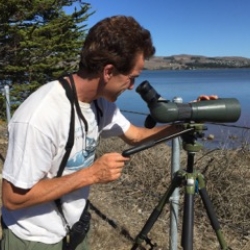Birding by Ear in the Sierra
Dates: June 15-20, 2025
Instructor: Daniel Edelstein
Fee: $500.00 + meals and accommodations fees
Term: Summer 2025
Workshop Description
Designed for both beginners and experienced birders, this workshop will feature: a) introducing you to 20+ common nesting day and night-active bird species in the Sierra via classroom and field trips; b) share diverse methods to improve your Birding By Ear skills, including handouts; employment of books, articles, and apps; and several other techniques; and c) introduce the “why, what, where, when, and how” of song development and its usage by birds for courtship, defense, and migration.


Instructor Bio
Since the 1990s, Daniel Edelstein has been a freelance Avian Biologist and Certified Wildlife Biologist Asc. As a returning instructor to the Field Station, he has led birding tours for more than 25 years and presented birding college classes and public presentations in more than 20 states, including week-long and long-form adult classes such as "Bird Song Ecology," "Birding By Ear," "Intro. To Ornithology," and several others at the college level. Daniel’s popular website (WarblerWatch.com) hosts diverse birding handouts (via the Birding Links pulldown menu), and his warbler-centric blog has hosted warbler articles and photo quizzes since 2007. His Sierra Nevada birding began in the 1980s and he regularly visits birding "hot spots" near the Sierra Nevada Field Station, including Yuba Pass, Sierra Valley, and the Gold Lakes region.
Workshop Details
Workshop Schedule
Plan to arrive at the Sierra Nevada Field Campus on Sunday evening. We can get acquainted that evening after dinner, but the class will begin at 7:30 a.m. on Monday. Each day we will generally spend the morning in the field, have an afternoon break, and return to the field in the late afternoon. Lectures and discussions will be held informally in the field or in the evening. The class will end on Friday afternoon.
Workshop Supplies List
Field gear:
- binoculars (a must)
- spotting scope (optional)
- field guides
- notebook
PRINT RESOURCES:
- Peterson Field Guide to Birds Sounds of Western North America, Nathan Pieplow, $19.99; 31 used from $7.24 on up. Order via: amazon.com/Peterson-Sounds-Western-AmericaGuides/dp/0547905572/ref=sr_1_1?dchild=1&keywords=Nathan+Pieplow%2C+Field+Guide+to+Western&qid=1614989283&sr=8-1
- The Birder’s Handbook. Paul R. Ehrlich, David Dobkin, Darryl Wheye. Simon & Schuster. New York. 1988. (paperback) ISBN-10: 0671659898 New: $4.18 at: https://ca-en.nicebooks.com/search?q=The+Birder%E2%80%99s+Handbook
- National Geographic Field Guide to the Birds (Paperback) by Jon L. Dunn, Jonathan Alderfer, 7th edition ISBN 13: 9780792253143; New: $19.79; Used: $12: https://www.amazon.com/National-Geographic-Field-Guide-America/dp/1426218354/ref=sr_1_1?dchild=1&keywords=National+Geographic+Field+Guide+to+the+Birds+of+North+America%2C+7th+Edition+%287th+edition%29&qid=1614989170&sr=8-1
- Birds of the Sierra Nevada, Edward C. Beedy, Edward Pandolfino, Univ. of CA Press, 2013
- Handbook of Bird Biology, Cornell Lab of Ornithology, 3rd edition
ONLINE RESOURCES
- AllAboutBirds.org
- Singing Life of Birds, Donald E. Kroodsma; go to: http://tinyurl.com/h5a3aek Or purchase book via ISBN-10: 030795792; ISBN-13: 978030795792; New: $15.01: https://ca-en.nicebooks.com/search?q=The+Sibley+Field+Guide+to+Birds+
- Birding Northern California: Site Guides to 72 of the Best Birding Spots, Jean Richmond, via: https://mtdiabloaudubon.org/wp-content/uploads/2019/06/Birding-Northern-California-by-Jean-Richmond.pdf
- Birds of the World: subscription-based online resource that provides comprehensive life history. This resource is the ultimate one to become an advanced birder beyond your current ability. It is a suggested resource that will help you master your birding/birding by ear skills. Why? It hosts detailed, comprehensive natural history information for 720 USA bird species; see: birdsoftheworld.org to subscribe. Each species hosts a “Sounds & Behavior” chapter.
APPS
- iBird Pro
- Sibley V2
- Merlin Bird ID
- Hear Birds Again
- Sibley Hummingbird
Lodging and Camping Supplies
Camping gear if you are staying on campus:
- tent and sleeping pad (unless you are staying in our tent with a cot provided)
- warm sleeping bag
- pillow, toiletries, and towel
- flashlight and lantern
- alarm clock
Field gear for everyone:
- day pack
- sunscreen
- insect repellant
- water bottles
- plastic containers for packed lunches
- sense of humor
You might also want to bring:
- camera
- binoculars
- hand lens
- camp chair
Clothing:
The weather in the Sierra Nevada can vary greatly, even in a single day. Be prepared for chilly temperatures at night, even below freezing early in the summer. Rain is a possibility any time, whether forecast or not. Variable weather clothing that can be layered is best: long pants and a long-sleeved shirt, warm sweater and jacket, t-shirt and shorts or skirt, sturdy shoes or hiking boots, sun hat, rain gear, and a warm hat or gloves for cold weather and/or night activities. And, if you come later in the season, bring your swimsuit for afternoon dips in the lakes!